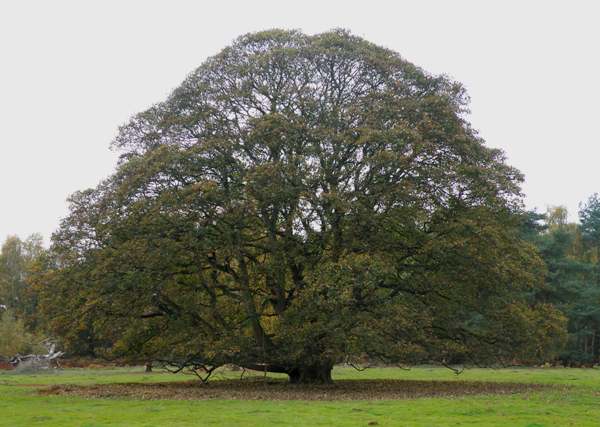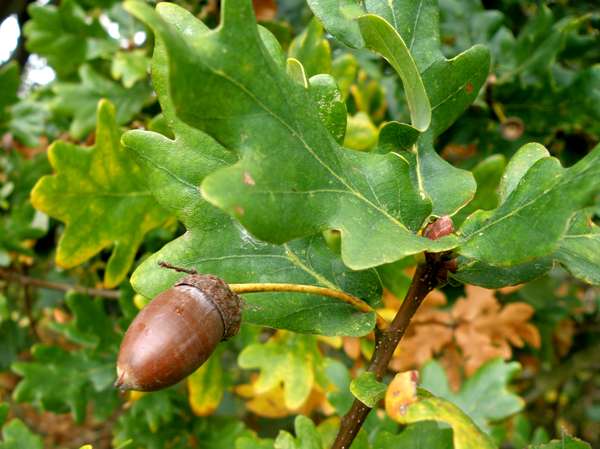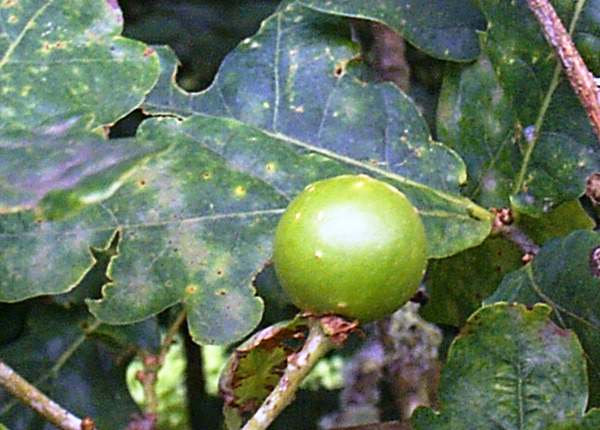Trees Birds Mammals Fish Amphibians Reptiles
Wild Algarve
Bookshop
Quercus robur - English Oak
Phylum: Magnoliophyta - Class: Magnoliopsida - Order: Fagales - Family: Fagaceae

Also known as the Pedunculate Oak, a mature English Oak is a
magnificent sight; some attain a spread of 45m and a can be as tall as 50m. The leaves of the English oak have no stalks, while its acorns are stalked.
In Britain we have just two native oaks plus a few naturalised imports. Sessile Oaks, Quercus petraea, are more common on upland acid soils; they have stalked leaves but their acorns are sessile, having no stalks. The problem is remembering which way round it is!

There are other distinguishing features – for example, the lobes of the leaves of Sessile Oaks are more forward pointing, and the acorns are shorter and more conical than those of English Oaks.
Seen from a distance, a key identifying feature is the very short trunk that branches close to the ground - often so low that you have to duck down to get close to the trunk.
Oaks provide much-favoured habitat for
birds, squirrels and a wide range of insects, spiders and other tiny
creatures. These slow-growing trees have wide root systems and are good at
resisting riverbank erosion.
Their tough rot-resistent timber is just one of the reasons that oaks are highly valued. There are more than 500 oak species worldwide, providing people with timber, cork, dyes and much more.

Leaves and acorn of an English Oak

Oak apple
Oak apples are galls caused by the tiny larvae of the gall wasp, Andricus kollari. The insect lives within the
oak apple and bores a hole to the outside world when it is fully mature. Green when young, the oak apples turn brown and become very hard as they dry out during the summer months.
Fungi associated with oaks
Oak trees are host, home and harvest for many kinds of fungi, and because fallen oak leaves take two or three years to rot they provide habitats for many more litter-recycling species than can be found beneath trees with fast-decaying leaves (for example Ash trees). Here are three conspicuous fungi that are either specific to oak trees or at least are rarely seen anywhere else.

Lactarius quietus, the Oakbug Milkcap, is an ectomycorrhizal (EM) fungus whose mushrooms often appear in huge numbers among the leaf litter beneath oak trees. Many other mycorrhizal fungi, including several from the family Russulaceae that includes the milkcaps, are associated either exclusively or commonly with oak trees. Among these is the Yellowdrop Milkcap, Lactarius chrysorrheus; unfortunately (for those who like to gather wild mushrooms to eat, that is) this fairly common milkcap is known to be poisonous, even when cooked thoroughly.

Grifola frondosa, commonly called Hen of the Woods, is a polypore from the family Meripilaceae that appears in the autumn at the bases of old oak trees. This weak parasite grows on the roots. It is not an instant killer, and so once you find an infected tree it is usually possible to return and see fresh fruitbodies there for several successive years. A similar but much rarer species, Polyporus umbellatus, is also mainly found under oak trees, unlike its relative the Wood Cauliflower, Sparassis crispa, which grows on the basal roots of conifers such as the Scots Pine.

Among the many wood-rotting fungi that are partial to oaks is a bracket that, in Britain at least, rarely occurs on anything other than dead oak timber. Daedalea quercina, the Oak Mazegill, belongs to the family Fomitopsidaceae; it is a saprophytic fungus with very wide gill-like pores
radially-aligned in a pattern that resembles a maze - hence the common name.